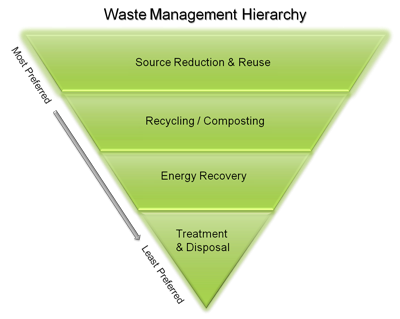Waste Management Hierarchy and Homeland Security Incidents
EPA developed a four-tiered waste management hierarchy to guide waste management decision-making. During any incident, an important goal of waste management should be to reduce the amount of disposable waste and preserve valuable, limited landfill space. This goal can be met by reusing and recycling as much material and waste as possible. Many incidents, including those involving chemical, biological or radiological agents, may present opportunities for waste minimization, reuse and recycling to decrease the amount of waste requiring disposal. Prior planning for potential incidents should include identifying opportunities for waste minimization and developing criteria and options for reuse and recycling. Options available for each type of incident should be documented in a pre-incident waste management plan.
On this page:

Reduce
Before an incident occurs, communities can take steps to reduce the amount and toxicity of incident-generated waste. For example, the community can minimize waste and mitigate the hazards in their neighborhoods by updating building codes or retrofitting PCB transformers. Communities can limit the possible spread of contamination by sealing access points to the sewer or water system with drain covers. The initial planning and preparation efforts communities take to minimize the amount and toxicity of incident-generated waste have several environmental benefits (e.g., reducing the amount of new materials needed to rebuild), as well as economic benefits (e.g., shortening the recovery timeline).
Reuse
Reuse refers to materials that can be used again in their original form. These items typically are not removed from the site. Communities should evaluate their reuse program to ensure it can be scaled up to handle incident-generated materials, if necessary. To maximize reuse opportunities for different materials during an incident, a viable reuse infrastructure, such as end markets for salvaged products, should be in place prior to an incident. In addition, communities should establish and document guidelines in their pre-incident waste management plans for salvaging and reusing various materials. Risk communication should be a part of waste-related community outreach plans to help ensure public acceptance of the salvaged materials.
Recycle
Recycling is the process of collecting and processing materials that would otherwise be disposed of as waste and turning them into new products. Items usually are recycled off-site. However, in some circumstances, waste can be recycled on-site (e.g., asphalt recycling or breaking up and grinding concrete on-site for immediate use in backfill). Communities should evaluate their recycling program for everyday wastes to ensure it can be scaled up to handle incident-related wastes, if necessary. To maximize recycling opportunities for different waste streams during an incident, a viable recycling infrastructure, such as recycling facilities and end markets for recycled products, needs to be in place prior to an incident. For example, green building programs, local waste management ordinances and building code requirements can encourage the creation and help maintain a robust and functioning recycling infrastructure. In addition, communities should establish criteria for recycling various waste streams. Risk communication should be addressed in waste-related community outreach plans to help ensure public acceptance of recycled products made from incident-related wastes.
For additional information on possible recyclers and other waste management companies that may manage disaster debris, see EPA Region 5's Disaster Debris Recovery Database. This interactive map provides information and locations of over 3500 facilities throughout Illinois, Indiana, Michigan, Minnesota, Ohio and Wisconsin.
